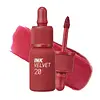What's inside
What's inside
 Key Ingredients
Key Ingredients

No key ingredients
 Benefits
Benefits

No benefits
 Concerns
Concerns

 Ingredients Side-by-side
Ingredients Side-by-side

Dimethicone
EmollientDimethicone/Vinyl Dimethicone Crosspolymer
Skin ConditioningWater
Skin ConditioningPolyglyceryl-2 Triisostearate
EmulsifyingCetyl PEG/PPG-10/1 Dimethicone
EmulsifyingIsododecane
EmollientButylene Glycol
HumectantVinyl Dimethicone/Methicone Silsesquioxane Crosspolymer
CI 77491
Cosmetic ColorantDimethicone Crosspolymer
Emulsion StabilisingCI 15985
Cosmetic ColorantCI 77891
Cosmetic ColorantCI 15850
Cosmetic ColorantCI 19140
Cosmetic ColorantPEG-60 Hydrogenated Castor Oil
Emulsifying1,2-Hexanediol
Skin ConditioningVp/Hexadecene Copolymer
Disteardimonium Hectorite
StabilisingCI 77499
Cosmetic ColorantPhenoxyethanol
PreservativePropylene Carbonate
SolventParfum
MaskingCI 45410
Cosmetic ColorantAluminum Hydroxide
EmollientCI 42090
Cosmetic ColorantDimethicone, Dimethicone/Vinyl Dimethicone Crosspolymer, Water, Polyglyceryl-2 Triisostearate, Cetyl PEG/PPG-10/1 Dimethicone, Isododecane, Butylene Glycol, Vinyl Dimethicone/Methicone Silsesquioxane Crosspolymer, CI 77491, Dimethicone Crosspolymer, CI 15985, CI 77891, CI 15850, CI 19140, PEG-60 Hydrogenated Castor Oil, 1,2-Hexanediol, Vp/Hexadecene Copolymer, Disteardimonium Hectorite, CI 77499, Phenoxyethanol, Propylene Carbonate, Parfum, CI 45410, Aluminum Hydroxide, CI 42090
Dimethicone
EmollientVinyl Dimethicone/Lauryl Dimethicone Crosspolymer
Diisostearyl Malate
EmollientPolyglyceryl-2 Triisostearate
EmulsifyingTribehenin
EmollientSilica
AbrasiveQuartz
AbrasiveAlumina
AbrasivePolymethylsilsesquioxane
Sorbitan Isostearate
EmulsifyingCetyl PEG/PPG-10/1 Dimethicone
EmulsifyingVp/Hexadecene Copolymer
Tocopheryl Acetate
AntioxidantPhenoxyethanol
PreservativeCI 77492
Cosmetic ColorantCI 77491
Cosmetic ColorantCI 77499
Cosmetic ColorantCI 77891
Cosmetic ColorantCI 15850
Cosmetic ColorantCI 42090
Cosmetic ColorantDimethicone, Vinyl Dimethicone/Lauryl Dimethicone Crosspolymer, Diisostearyl Malate, Polyglyceryl-2 Triisostearate, Tribehenin, Silica, Quartz, Alumina, Polymethylsilsesquioxane, Sorbitan Isostearate, Cetyl PEG/PPG-10/1 Dimethicone, Vp/Hexadecene Copolymer, Tocopheryl Acetate, Phenoxyethanol, CI 77492, CI 77491, CI 77499, CI 77891, CI 15850, CI 42090
 Reviews
Reviews

Ingredients Explained
These ingredients are found in both products.
Ingredients higher up in an ingredient list are typically present in a larger amount.
This ingredient is a high molecular weight silicone. It has emulsifying and skin conditioning properties.
Ci 15850 is the pigment color red. It is an azo dye and created synthetically.
Azo dyes need to be thoroughly purified before use. This allows them to be more stable and longer-lasting.
This ingredient is common in foundations, lipsticks, and blushes. This color is described as brown/orangey red.
It has many secondary names such as Red 6 and Red 7. According to a manufacturer, Red 6 usually contains aluminum.
Learn more about CI 15850Ci 42090 is a synthetic dye created from petroleum. It is used to give a bright blue color to cosmetics, medicine, and food.
Ci 77491 is also hydrated iron III oxide. It's sole purpose is to give a red/pink hue to products.
Iron III oxides are classified as inorganic chemicals for coloring.
Synthetically created Ci 77491 is considered safer than those naturally found. This is because the synthetically created version may contain less impurities. Iron oxides are generally non-toxic and non-allergenic.
Learn more about CI 77491Ci 77499 is also hydrated iron III oxide. It is created from mixing red and black iron oxides. This helps give shades of darkness to a product.
Iron III oxides are classified as inorganic chemicals for coloring.
Ci 77891 is a white pigment from Titanium dioxide. It is naturally found in minerals such as rutile and ilmenite.
It's main function is to add a white color to cosmetics. It can also be mixed with other colors to create different shades.
Ci 77891 is commonly found in sunscreens due to its ability to block UV rays.
Learn more about CI 77891Dimethicone is a type of synthetic silicone created from natural materials such as quartz.
What it does:
Dimethicone comes in different viscosities:
Depending on the viscosity, dimethicone has different properties.
Ingredients lists don't always show which type is used, so we recommend reaching out to the brand if you have questions about the viscosity.
This ingredient is unlikely to cause irritation because it does not get absorbed into skin. However, people with silicone allergies should be careful about using this ingredient.
Note: Dimethicone may contribute to pilling. This is because it is not oil or water soluble, so pilling may occur when layered with products. When mixed with heavy oils in a formula, the outcome is also quite greasy.
Learn more about DimethiconePhenoxyethanol is a preservative that has germicide, antimicrobial, and aromatic properties. Studies show that phenoxyethanol can prevent microbial growth. By itself, it has a scent that is similar to that of a rose.
It's often used in formulations along with Caprylyl Glycol to preserve the shelf life of products.
This ingredient is a form of glycerin with emulsifying and emollient properties.
As an emulsifier, this ingredient helps keep products together while adding a thick texture. The manufacturer states this ingredient has emollient properties. Emollients help keep the skin hydrated by trapping moisture in.
Polyglyceryl-2 Triisostearate is created by reacting diglycerin and isostearic acid. Due to the isostearic acid base, it may not be safe for Malassezia or fungal acne.
Learn more about Polyglyceryl-2 TriisostearateVP/Hexadecene Copolymer is a synthetic film-forming agent. It has both water and oil loving properties, allowing it to create a flexible, even film on the skin.
This ingredient helps enhance texture, smoothness, and wear resistance in makeup products while reducing tackiness.